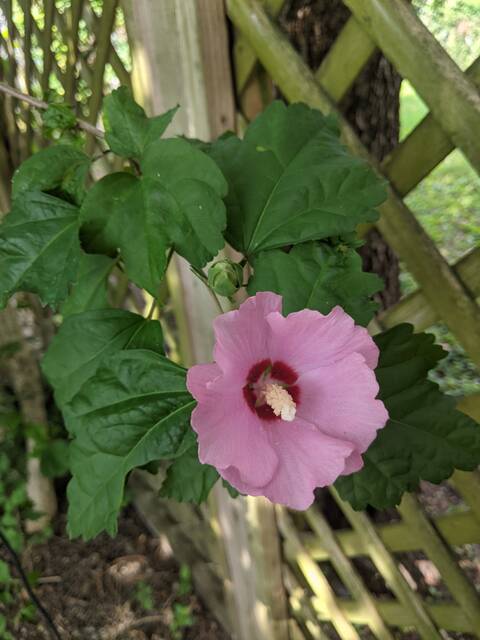
Every part of The Rose of Sharon is edible; leaves, blossoms and bark — it contains vitamin C and Anthocyanins which are antioxidants.
When I moved back into my grandmother’s home at 118 East Third Street things had changed more than a little bit.
My grandparents purchased the house from Knox & Bros Funeral home in the early 1950’s. Throughout the next few decades, they lived upstairs with seven daughters and worked downstairs where they had a chiropractic clinic. After my grandfather died, the space was converted into additional business space and later apartments.
Although the inside was renovated numerous times, the back garden remained basically the same. Nan-Nan, my grandmother, had several rose bushes she was proud of along with an old cherry tree.
After Nan-Nan moved out of the family home and sold it to my mother in the early 2000’s, the back garden became a much-needed parking area. It’s still hard to not walk down the back steps and envision playing kickball or freeze tag down the old stone path, all the while carefully avoiding the rose bushes.
I moved back into the old house about ten years ago. I moved to and from Maysville a few times but always kept a spot in the part of the house my grandmother had lived in the most. I slowly began renovating the home and working to make the parking lot into a more inviting space.
About five and a half years ago I began attempting to make the backyard, or garden as I prefer to think of it, a greener space. We have been able to grow flowers, herbs, and even ferns along the fence line. Each year adding a few touches but realizing mother nature had her own plan. In recent years out of what felt like nowhere, I began to notice a mulberry tree, lilies, hostas and large hibiscus bushes. The now large additions to the home feel like they have always been here. They get a little bigger each year and now I can’t begin to imagine the terrain without them.
Early this week I had two friends stop by for a quick visit on their way to the river cruise in town. One of the friends was visiting from Paris, Kentucky. She quickly recognized the hibiscus bush as the “Rose of Sharon.” To be honest I wasn’t sure what the bush was exactly. Over the years I have had people tell me they were azalea bushes, which they are not. And even someone told me once it was a bush they used to grow in old outhouses. And maybe they did.
Once I realized it was a hibiscus it seemed so obvious. I couldn’t believe I had missed it.
The part that tickled me the most was when she asked me if I realized the plant was edible. I certainly did not. I thought I had foraged everything you could forage in my backyard, but here I was missing what was blatantly in front of me.
The friend recommended I treat the blooms like squash blossoms and stuff them with cheese, bread them and fry them. Along with that suggestion, she encouraged me to look them up because there were all sorts of edible options for this summer delight.
Rose of Sharon is South Korea’s national flower. It’s called Rose Mallow in the United Kingdom and St. Joseph’s Rod in Italy. It’s a deciduous shrub native to Asia and the name comes from an Israeli Valley named Sharon. A rose is a rose unless it’s a Rose of Sharon, and then it’s a hibiscus. Some say it’s the name of crocus and others swear it’s the name of a tulip and then there’s some confusion with the lily of the valley. Poor plant, most likely it lives in a state of constant identity crisis, never knowing on which side of the garden it should grow.
Today I have included a few of the new tricks and interesting facts I have found about this interesting plant. It is always nice to be reminded there are so many different flavors and beautiful props mother nature provides for us, right under our nose.
Rose of Sharon
Medicinal Properties:
— Buds contain mucilage, a gooey medicinal compound made of polysaccharides, found in most species of the mallow family. Mucilage can be used to heal burns, wounds, gastric ulcers and internal and external inflammation and irritation, such as sore throats or urinary tract infections.
— Every part of The Rose of Sharon is edible leaves, blossoms and bark- it contains vitamin C and Anthocyanins which are antioxidants.
— Root bark-Current studies are showing promising results with the root bark for inhibiting the proliferation of lung cancer. The root bark is used by the Chinese as an anti fungal remedy. It is also said to calm the nerves.
Edible Ideas
Every part of this plant is edible.
— Use flowers and leaves in salads-Chop the blossoms or use whole flowers.
— Make tea from the leaves and flowers and drink as an antioxidant.
— Add flowers and leaves to soups and quiche.
— Chopped blossoms make beautiful decorations on cakes and the mild flavor blends well.
— Opened blossoms make great dip holders.
— Rose of Sharon water can be enjoyed with raw honey or used for making tea.
Stuffed Rose of Sharon
SAVORY
— 8 Rose of Sharon flowers, pistils and stamens removed
— 1 cup soft, preferably local, cheese
— 2 tablespoons minced chives
— 1 teaspoon sumac powder
— ⅛ teaspoon Kosher salt
Combine the cheese, chives, sumac powder, and salt in a bowl. Mix the ingredients and blend.
Spoon 1 tablespoon of filling into each flower. Arrange on a wood board or appetizer plate and serve. The above quantities will fill 8 flowers. This recipe is scalable.
SWEET
— 8 Rose of Sharon flowers, pistils and stamens removed
— 1 cup soft
— 4 teaspoons honey
— 2 tablespoons chopped fruit (juneberries, barberries, blueberries, etc.)
Put the above ingredients in a blender or food processor and blend until the texture is smooth. Spoon 1 tablespoon of filling into each flower. Arrange on a dessert plate and serve. The above quantities will fill 8 flowers.
The recipe and photo used in today’s article are from the kitchen of Chef Babz ([email protected]).





